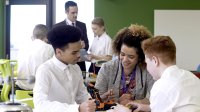Connecting a District With Flash Lessons
Flash lessons get administrators out of their offices and into classrooms—and can strengthen their connections with teachers.
In my second year as chief academic officer of Collingswood-Oaklyn Public Schools in New Jersey, I started a series of what I call flash lessons—short lessons taught by me in district teachers’ classrooms. These were instrumental in helping me build rapport with our teachers.
I wrote about flash lessons more than a year ago, but as I recently reflected on my experiences, I also asked some of our teachers about how they perceived my visits to their classes. I’d like to share some of their reflections here.
The Chemistry of Attraction
I taught a flash lesson called “The Chemistry of Attraction” in Kathryn Ribay’s high school Integrated Science class, and it was outside my comfort zone. Having zero knowledge of thermochemistry, I did some research and then thought about how and why people develop “chemistry.”
Teacher reflection: The process was simple: We picked a date, I gave Brian a sense of where we were in our energy unit, and he came back with a tangentially related lesson idea which culminated in students using a mathematical equation to represent their “ideal boyfriend or girlfriend.” A critique that I have seen of flash lessons is that they involve administrators teaching a topic that they are far from expert in, yet this imbalance led to one of my favorite moments of the day: Brian asked the students to explain thermochemistry, and one of them, who had been struggling with the material, launched into a detailed and accurate explanation of recent concepts. His monologue was capped off with a round of applause from the whole class.
That day, my students, many of whom had struggled with math and science, had the opportunity to teach as well as to learn, and this gave them a chance to recognize and take pride in their own knowledge. The students were not the only ones to benefit; the flash lesson also gave me the chance to observe a master teacher interacting with my students and learn from how he worked with them—all without leaving my classroom or arranging for coverage.
World War You
I asked students in Eric Feldman’s Special Education U.S. History II class to consider their own “world war” within the context of WWII concepts: “unfinished business,” central figures, theaters, liberation, and “the end.” I called the lesson “World War You.”
Teacher reflection: Mr. Kulak began by asking students to consider their “World War You.” Before they started, Mr. Kulak shared a personal “war” he had fought. As we both circulated about the room, students slowly began to share. One student, who had gone through a similar “war” as Mr. Kulak, shared his story with openness and honesty. The lesson was a powerful tool for the students to be introspective about their own stories, to be more responsive and respectful to others, and to accept that we all have our personal wars.
Massey’s Mad Libs
“Massey’s Mad Libs,” my first flash lesson in an elementary school class, was particularly special because it was the first with one of my former students. Danielle Massey invited me into her first-grade Writer’s Workshop block, during which we worked on parts of speech through an original Mad Lib that I created about Danielle.
Teacher reflection: It was a cool experience to be the student again as well as a nice reminder that administrators were once teachers, too.
We need administrators who know the classroom lingo and have experience teaching. I love the idea of flash lessons because high school and elementary are two completely different worlds. Brian recognized that and got his feet wet in an elementary setting, knowing it could have flopped because his experience is in high school. The thought he puts into preparing his flash lessons shows teachers that he cares.
My Evolution
With only a rudimentary knowledge of evolution, I asked the students in Cheryl Fisher’s ninth-grade Honors Biology class to apply the basic tenets of evolution, origin, mutation, and adaptation to their own lives, in a lesson called “My Evolution.”
Teacher reflection: This lesson helped my students realize that over time things change and that there are many factors that mold us into who we are now.
I was encouraged to participate as a student, sharing my experience as a teacher. It not only helped my students get to know me better, but also helped Brian get an idea of who I am and how I interact with my students. Brian also shared his own experiences, making the teacher-supervisor relationship stronger. With so many walk-throughs and observations, I think it’s essential for the students not to fear visitors or supervisors.
Art Gallery
In Elisabeth Yucis’s ninth-grade English Language Arts class, I shared random, wacky Google images in a lesson called “Art Gallery.” I asked students to speak extemporaneously as if they were curators in their own art galleries.
Teacher reflection: What I most appreciated was the chance to see my students in a new light. When I could take a step back and see someone else work with my students, I noticed things about them that I hadn’t noticed before, giving me a fuller picture of each student.
